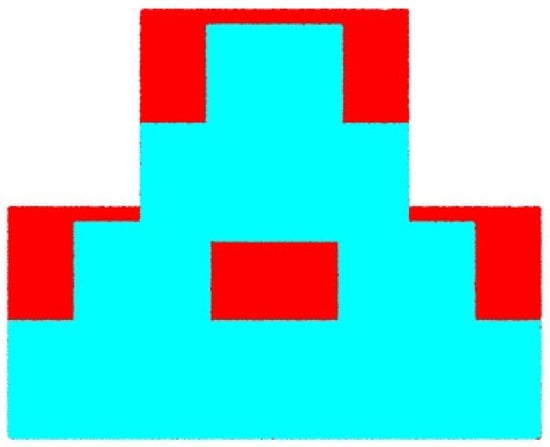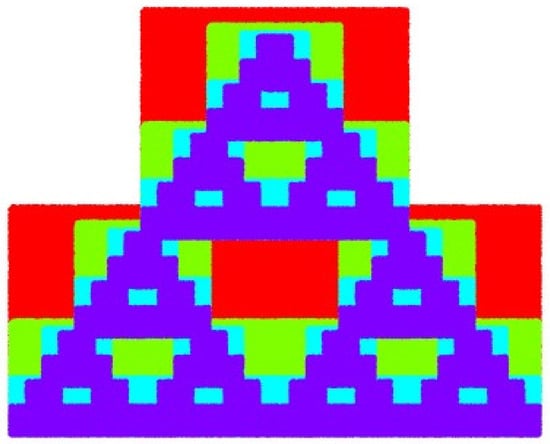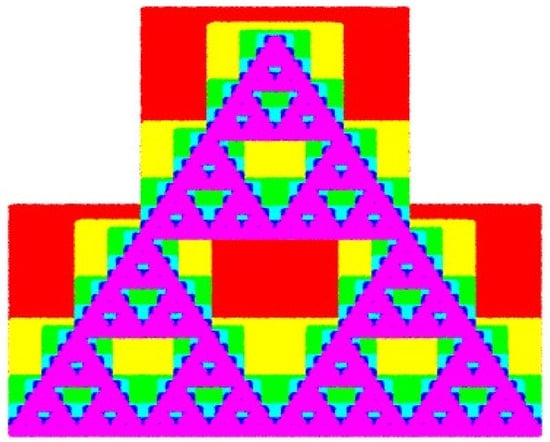Abstract
In this manuscript, we introduce the concept of fuzzy S-metric spaces and study some of their characteristics. We prove a fixed-point theorem for a self-mapping on a complete fuzzy S-metric space. To illustrate the versatility of our new ideas and related fixed-point theorems, we give examples to illustrate their use in a variety of domains, including fractal formation. These examples illustrate how the fuzzy S-contraction can be applied to iterated function systems, enabling the exploration of fractal forms under diverse contractive conditions. In addition, we solve the satellite web coupling problem by employing this coherent framework.
1. Introduction
Finding the distance between two or more objects that may be difficult to measure precisely is a requirement in many real-world scenarios. As a result, we need a suitable metric to model different practical difficulties. There are a number of methods for more accurate distance measurement that are being used to expand the scope of fixed-point (FP) theory research. In the theory of fixed points, both unique and non-unique FP conclusions have been extensively studied from various angles using different metrics. In many branches of mathematics, including applied mathematics, topology, and analysis, metric spaces (MSs) are crucial. Thus, a number of FP results were discovered after studying various generalizations of MSs. Numerous authors have studied the FP theory in generalized metric space. For instance, the notions of 2-MSs and D-MSs were first proposed by Gahler [] and Dhage [], respectively; however, other writers noted that these attempts are invalid (see [,]). An S-metric space (S-MS) was first proposed by Sedghi et al. [] in 2012, and it was demonstrated that this concept represents a generalization of an MS. Furthermore, they established some FP theorems on S-metric spaces and demonstrated certain features of these spaces. In Ref. [], Sedghi and Dung generalized their own work and derived numerous analogues of FP theorems in S-MSs. The fuzzy set idea was initially presented by Lotfi A. Zadeh in 1965 []. The term “fuzzy” refers to vagueness or ambiguity. Fuzziness arises when the boundaries of a piece of information are not precisely defined. Fuzzy sets are characterized by elements that possess varying degrees of membership, serving as a generalization of the traditional concept of a set. Numerous researchers have proposed different approaches to defining fuzzy metric spaces. The fuzzy perspective on distance is based on the idea that the distance between two points is a fuzzy concept instead of a definite real value that can be calculated or estimated. Building on these ideas of fuzziness and ambiguity in the closeness of objects, in 1975, Kramosil and Michalek defined fuzzy metric space (FMS) and introduced related concepts []. George and Veeramani [] proposed and examined a concept of fuzzy metric space based on continuous t-norm (CTN). Their approach represents a refined and appealing variation of the frameworks earlier introduced by Kramosil and Michalek [] as well as Kaleva and Seikkala []. Grabiec, M. [] was the pioneer in exploring fixed-point theory within FMSs and developed a fuzzy analog of Banach’s principle. He integrated the idea of contraction into the structure of fuzzy metrics, laying the foundation for concepts such as sequence convergence, Cauchy sequences, and completeness in this framework. Zahid [] also presents new modifications in fixed-point theory.
Since self-similar sets offer a potent means of incorporating a broad variety of physical phenomena into mathematical models, they are crucial to the study of fractals. Hutchinson’s seminal study [] made a significant advance in this subject, exploring concepts of self-similarity. Iterated function systems (IFSs), which were developed as a result of his pioneering work, are now a crucial tool for producing self-similar fractals. Hutchinson’s groundbreaking work was further supported by Barnsley []. Iterated function systems (i.f.ss) are introduced as a unified way of generating a broad class of fractals. These fractals are often attractors for i.f.ss and occur as the supports of probability measures associated with functional equations. Zahid et al. [] introduced a novel iterated function system (IFS) called the F-Proximal Iterated Function System (F-PIFS) and proposed a new technique for generating fractals. Unlike traditional methods that produce a single fractal, their approach enables the simultaneous generation of two fractals, opening a new direction in fractal theory. Recently, in 2024, Shaheryar et al. [] introduced fuzzy enriched contraction and generating fractals using this generalized contraction.
Fixed-point theory plays a crucial role in various scientific and engineering applications. The Gaussian Decomposition Algorithm [] relies on iterative refinements for signal decomposition, ensuring convergence through fixed-point principles. In echo signal detection [], contraction mappings aid in filtering weak signals from noise. The information transmission model [] benefits from fixed-point methods in optimizing error correction and data efficiency. Additionally, optical structures for lightweight materials [] use fixed-point approaches to stabilize wave propagation and optimize optical networks. These applications highlight the significance of fixed-point theory in signal processing, communications, and material design.
Fuzzy metric spaces have been extensively studied due to their applicability in various domains such as image processing, decision-making, and complex network modeling. However, conventional fuzzy metric spaces often exhibit limitations when dealing with multi-point relationships and dynamic systems. Traditional fuzzy metric spaces primarily focus on pairwise distance measures, which may not adequately capture interactions in scenarios where three or more elements interact simultaneously. To overcome these limitations, we introduce the fuzzy S-metric space (FS-MS), which extends the traditional fuzzy metric structure by incorporating a three-point distance measure. This modification is particularly useful in applications such as fractals and satellite web coupling, where multi-point dependencies play a crucial role in defining structural and topological properties. In fractals, distance measures must accommodate self-similarity and iterative transformations, which FS-MS effectively models through its generalized inequality condition. Similarly, in satellite web coupling, the interaction between multiple nodes in a dynamic network requires a robust and flexible metric, which FS-MS provides by enforcing associativity via the composition property. Thus, FS-MS provides a more robust framework for analyzing fractal structures and satellite web systems, making it an indispensable tool in these contexts.
In order to integrate the idea of fuzzy S-contractions within complete fuzzy S-MSs, we introduce a new metric space, called the fuzzy S-metric space, which generalizes both the fuzzy metric space and the S-metric space. Additionally, we propose a novel S-iterated function system (S-IFS) along with its associated H–B operator. We aim to prove the existence of a single attractor for the S-IFS by utilizing the proven FP theorem. In order to clarify the suggested architecture, we offer a tangible illustration that demonstrates how fuzzy S-contractions are used to create fractals. We hope to highlight the effectiveness of our method in producing complex geometric objects with self-similar qualities through this example demonstration. In conclusion, by presenting the idea of fuzzy S-contractions, this study seeks to improve our understanding and use of fuzzy S-contraction mappings. By investigating their characteristics and using them in the context of S-IFS, we want to further the study of fractal geometry and offer important new perspectives on the creation of intricate fractal designs.
2. Preliminaries
In this section, we discuss some basic definitions from the existing literature.
Definition 1.
([]). An operation that is binary is referred to as a CTN if the binary operation ⊠ is associative, commutative, and continuous, and also if ⊠ satisfies the boundary condition, i.e.,
, and ⊠ is monotonic, i.e.,
Definition 2.
([]). Let Ω be a non-empty set. A function that meets the following criteria is an S-metric on Ω . For any ,
- ,
- ,
The pair is called an S-metric space.
Definition 3.
The 3-tuple is a fuzzy S-metric space (FS-MS) if Ω is an arbitrary set, ⊠ is a CTN, and is a fuzzy set on that fulfills the requirements listed below:
- ⇔,
- is left-continuous and non-decreasing for all and .
Definition 4.
A sequence in an FS-MS converges to
if for each . A sequence in an FS-MS is Cauchy if for each and .
An FS-MS is said to be complete if every Cauchy sequence is convergent in it.
Lemma 1.
In an FS-MS, we also have .
Proof.
Definition 5.
Let be an FS-MS. A fuzzy S-contraction is defined as a mapping if there is a constant such that
Theorem 1.
Let be a complete FS-MS such that
Let be a fuzzy S-contraction on Ω. Then, F has a unique fixed point.
Proof.
Let and . Then,
which implies that
Thus, for any positive integer, m we have
By (5), according to (4), we now have
i.e., is a Cauchy sequence. Consequently, it converges in the complete FS-MS. Let us indicate
We will now demonstrate that is an FP of F. Thus, we have
Taking , we obtain
which implies that
Thus, we can deduce that . It remains to be verified that is a unique FP of F. For this, let such that . Then,
taking we obtain
which implies that . This concludes the proof. □
This theorem in the framework of FS-MS extends classical results by generalizing the contraction mapping principle to a multi-point setting. Unlike traditional fixed-point theorems, which are primarily based on pairwise distances, this theorem introduces a new contraction condition incorporating three-point distance measures. This advancement is crucial for applications requiring a more flexible and robust structure, such as dynamic networks and fractal-based models.
Example 1.
The ordinary multiplication for every is defined as . Let be the function defined on by
for all and . Then is an FS-MS called standard FS-MS, and is called the standard fuzzy S-metric induced by the S-metric. We only need to verify the triangle inequality, as the other properties are straightforward to check.
for all and .
Example 2.
Let ; then, is an S-MS. Let be an FS-MS defined by
Let be a mapping defined by . We are going to show that F is a fuzzy S-contraction on Ω. We have
and for , we obtain
Thus, F is a fuzzy S-contraction on Ω. So by Theorem (1), F has a unique FP which is .
3. Topology Induced by a Fuzzy S-Metric
Definition 6.
Let be an FS-MS. We define an open ball with center and radius , and as
Proposition 1.
Every open ball in an FS-MS is an open set.
Proof.
Consider an open ball . Now,
Since , we can find a , such that
. Let . Since , we may discover a , , s.t . We can now find , s.t for a given and s.t . The ball is now being considered. We assert that
Now, let
Therefore,
Therefore, . Hence, . □
Result 1.
Let be an FS-MS. Define
Then, τ is a topology on Ω.
Theorem 2.
Every FS-MS is Hausdorff.
Proof.
Let be the given FS-MS. Let be the two distinct points of . Then, . For some , , let . We can find a s.t for each , . Now, consider the open balls and . Clearly,
If there exists
then
which is a contradiction. Therefore, is a Hausdorff. □
Definition 7.
Let be an FS-MS and let τ be the topology induced by the FS-MS. The symbol will be used to indicate the collection of all compact subsets of Ω that are not empty. We define Hausdorff FS-MS , for as
where, = min
Thus, is a Hausdorff fuzzy S-metric on , making a Hausdorff FS-MS. It should be noted that the Hausdorff FS-MS is complete, provided that the FS-MS is complete.
Lemma 2.
Let be a fuzzy S-contraction on the FS-MS . Then, defined by
is a fuzzy S-contraction on .
Proof.
Suppose be a fuzzy S-contraction on the fuzzy S-metric space . Then,
for all , since is a fuzzy S-contraction. So F maps into itself. We will demonstrate that is a fuzzy S-contraction on . Let, for any and , us have
Similarly,
Equation (6) implies that
Thus, is a fuzzy S-contraction on . □
Definition 8.
Let be an FS-MS and be a family of fuzzy S-contractions. The operator defined by
for all , is a fuzzy S-Hutchinson–Barnsley (S-H-B) operator.
Definition 9.
Let be a complete FS-MS and be fuzzy S-contractions; then, is called a fuzzy S-iterated function system (S-IFS).
Definition 10.
A compact non-empty set is considered an attractor of fuzzy S-IFS if it satisfies and can be expressed as where .
Theorem 3.
Let be an FS-MS and be a family of fuzzy S-contraction. The operator is defined by
for all . Then, W is fuzzy S-contraction on .
Proof.
Proving the statement for is sufficient. Let be two fuzzy S-contractions. So, and will map into itself. Take with and . Then, lemma (2) makes it clear that
Similarly, it can be proven for any natural number N.
Hence, W is fuzzy S-contraction on . □
Theorem 4.
Let be a complete FS-MS and be a family of fuzzy S-contractions. The operator , which is defined by
for all . Then, W has a unique fixed , i.e., .
Proof.
From Theorem 3, is a fuzzy S-contraction on . Also, is a complete FS-MS, as implied by the completeness of . Thus, by Theorem 1, W has a unique FP , i.e., . □
Example 3.
Let ; then, is an S-MS, and denotes the Euclidean norm on Let be an FS-MS defined by
Let , defined by
and .
We are going to show that and are fuzzy S-contractions on Ω .
for we obtain . Thus, is a fuzzy S-contraction on Ω. Now, consider
for , we obtain
Thus, is a fuzzy S-contraction on Ω.
And similarly,
for , we obtain
Thus, are a fuzzy S-contractions on Ω.
Consider the S-IFS with the mapping given as
for all . Then, by Theorem 3,
Additionally, for any initial set , the sequence of compact set is convergent, i.e., .
4. Application to a Satellite Web Coupling Problem
Fixed-point theory has found numerous applications in various fields, including optimization, control systems, and nonlinear analysis. One emerging application is in satellite web coupling, which involves optimizing and stabilizing satellite networks for communication, navigation, and remote sensing. Recent studies have shown that fixed-point principles can play a crucial role in designing algorithms for satellite trajectory optimization and inter-satellite link stability [,,,,,,].
Inspired by the use of FP approaches in several real-world scenarios, we apply Theorem 1 to solve a satellite web coupling boundary value problem. A thin sheet joining two cylindrical satellites might be thought of as a satellite web connection. The radiation problem brought on by the web coupling between two satellites leads to the following non-linear boundary value problem:
where represents the radiation temperature at any given position is a positive, non-dimensional constant, whereas heat is emitted into space from the web’s surface at a temperature of zero. The constant absolute temperature of both satellites is denoted by K. separates the two satellites, a is a positive constant that characterizes the radiation properties of the web’s surface, the factor 2 is required since radiation originates from both the top and bottom surfaces, is thermal conductivity, and h is the thickness.
The Green function
Problem (7) is equivalent to
Let be a collection of functions on that are Riemann-integrable. Define an S-MS by . Clearly, is a complete S-MS, and . Then is an FS-MS defined by
and clearly, is a complete FS-MS as implied by the completeness of .
Theorem 5.
Let be a self map in a complete FS-MS , satisfying
Then, there is a unique solution to the satellite web coupling boundary value problem (7).
Proof.
Define a self map by
A fixed point of a self map F is obviously a solution to the satellite web coupling problem (7).
Now,
for we obtain
Therefore, Theorem 1 postulates are all verified. Because of this, F has a unique FP, and there is a unique solution to the satellite web coupling problem (7). □
Remark 1.
Theorems 1–5 establish key results in fuzzy S-metric spaces (FS-MS) by proving the existence and uniqueness of fixed points for fuzzy S-contractions. Theorem 1 ensures a unique fixed point for a single fuzzy S-contraction, while Theorems 3 and 4 extend this to a family of such contractions, demonstrating the contraction property and the existence of a unique fixed point in a complete FS-MS. Theorem 2 guarantees the Hausdorff property of FS-MS, supporting the validity of these results. Finally, Theorem 5 applies the fuzzy S-contraction framework to a boundary value problem, highlighting its significance in applied mathematics.
5. Conclusions
In this study, we introduced the concept of fuzzy S-metric spaces and explored their fundamental characteristics. By establishing a fixed-point theorem for self-mappings on complete fuzzy S-metric spaces, we provided a significant theoretical contribution to the field. To illustrate the versatility and applicability of our results, we presented examples demonstrating how fuzzy S-contractions can be effectively employed in fractal generation via iterated function systems under varying contractive conditions. Additionally, we applied our framework to solve the satellite web coupling problem, highlighting its potential for addressing complex, real-world challenges. These findings not only extend the scope of fuzzy metric spaces but also pave the way for future research and innovative applications in fuzzy systems, optimization, and nonlinear analysis.
Author Contributions
Conceptualization, I.K., M.S. and F.U.D.; methodology, I.K. and F.U.D.; software, M.S., U.I. and I.-L.P.; validation, F.U.D., U.I. and I.-L.P.; formal analysis, F.U.D.; investigation, I.K., M.S. and U.I.; resources, F.U.D. and I.-L.P.; data curation, I.K. and U.I.; writing—original draft preparation, I.K.; writing—review and editing, F.U.D. and U.I.; visualization, M.S.; supervision, F.U.D.; project administration, I.-L.P.; funding acquisition, I.-L.P. All authors have read and agreed to the published version of the manuscript.
Funding
This research received no external funding.
Data Availability Statement
Data will be available on demand from the corresponding author.
Conflicts of Interest
The authors affirm that they do not have any competing interests.
References
- Gähler, S. 2-metrische Räume und ihre topologische Struktur. Math. Nachrichten 1963, 26, 115–148. [Google Scholar] [CrossRef]
- Dhage, B.C. Generalised metric space and mappings with fixed point. J. Math. Anal. Appl. 1992, 329, 329–336. [Google Scholar]
- Mustafa, Z. A New Structure for Generalized Metric Spaces: With Applications to Fixed Point Theory. Ph.D. Thesis, University of Newcastle, Newcastle, NSW, Australia, 2005. [Google Scholar]
- Mustafa, Z.; Sims, B. Some remarks concerning D-metric spaces. In Proceedings of the International Conference on Fixed Point Theory and Applications, Valencia, Spain, 9–15 July 2003. [Google Scholar]
- Sedghi, S.; Shobe, N.; Aliouche, A. A generalization of fixed point theorems in S-metric spaces. Mat. Vesn. 2012, 64, 258–266. [Google Scholar]
- Sedghi, S.; Van Dung, N. Fixed point theorems on S-metric spaces. Mat. Vesn. 2014, 255, 113–124. [Google Scholar]
- Zadeh, L.A. Fuzzy sets. Inf. Control 1965, 8, 338–353. [Google Scholar] [CrossRef]
- Kramosil, I.; Michálek, J. Fuzzy metrics and statistical metric spaces. Kybernetika 1975, 11, 336–344. [Google Scholar]
- George, A.; Veeramani, P. On some results in fuzzy metric spaces. Fuzzy Sets Syst. 1994, 64, 395–399. [Google Scholar] [CrossRef]
- Kaleva, O.; Seikkala, S. On fuzzy metric spaces. Fuzzy Sets Syst. 1984, 12, 215–229. [Google Scholar] [CrossRef]
- Grabiec, M. Fixed points in fuzzy metric spaces. Fuzzy Sets Syst. 1988, 27, 385–389. [Google Scholar] [CrossRef]
- Zahid, M.; Ud Din, F.; Shah, K.; Abdeljawad, T. Fuzzy Fixed Point Approach to Study the Existence of Solution for Volterra Type Integral Equations Using Fuzzy Sehgal Contraction. PLoS ONE 2024, 19, e0303642. [Google Scholar] [CrossRef]
- Hutchinson, J.E. Fractals and self-similarity. Indiana Univ. Math. J. 1981, 30, 713–747. [Google Scholar] [CrossRef]
- Barnsley, M.F. Fractals Everywhere; Academic Press: Cambridge, MA, USA, 2014. [Google Scholar]
- Zahid, M.; Ud Din, F.; Younis, M.; Ahmad, H.; Öztürk, M. Mathematical Modeling of Fractals via Proximal F-Iterated Function Systems. Axioms 2024, 13, 881. [Google Scholar] [CrossRef]
- Shaheryar, M.; Ud Din, F.; Hussain, A.; Alsulami, H. Fixed Point Results for Fuzzy Enriched Contraction in Fuzzy Banach Spaces with Applications to Fractals and Dynamic Market Equilibrium. Fractal Fract. 2024, 8, 609. [Google Scholar] [CrossRef]
- Zhou, G.; Zhou, X.; Chen, J.; Jia, G.; Zhu, Q. LiDAR Echo Gaussian Decomposition Algorithm for FPGA Implementation. Sensors 2022, 22, 4628. [Google Scholar] [CrossRef] [PubMed]
- Zhou, G.; Xu, C.; Zhang, H.; Zhou, X.; Zhao, D.; Wu, G.; Zhang, L. PMT Gain Self-Adjustment System for High-Accuracy Echo Signal Detection. Int. J. Remote Sens. 2022, 43, 7213–7235. [Google Scholar] [CrossRef]
- Zhang, Y.; Wang, X.; Gang, Y.; Wang, J.; Wu, S.; Zhang, P.; Shi, Y. 6G SAGIN Information Transmission Model. IEEE Commun. Mag. 2025, 1, 1–8. [Google Scholar] [CrossRef]
- Zhou, G.; Xu, J.; Hu, H.; Liu, Z.; Zhang, H.; Xu, C.; Zhao, Y. Off-Axis Four-Reflection Optical Structure for Lightweight Single-Band Bathymetric LiDAR. IEEE Trans. Geosci. Remote Sens. 2023, 61, 1–13. [Google Scholar] [CrossRef]
- Schweizer, B.; Sklar, A. Statistical metric spaces. Pac. J. Math. 1960, 10, 313–334. [Google Scholar] [CrossRef]
- Gong, Y.; Yao, H.; Liu, X.; Bennis, M.; Nallanathan, A.; Han, Z. Computation and Privacy Protection for Satellite-Ground Digital Twin Networks. IEEE Trans. Commun. 2024, 72, 5532–5546. [Google Scholar] [CrossRef]
- Wang, Z.; Chen, M.; Guo, Y.; Li, Z.; Yu, Q. Bridging the Domain Gap in Satellite Pose Estimation: A Self-Training Approach Based on Geometrical Constraints. IEEE Trans. Aerosp. Electron. Syst. 2024, 60, 2500–2514. [Google Scholar] [CrossRef]
- Liu, X.; Lou, S.; Dai, W. Further results on “System identification of nonlinear state-space models”. Automatica 2023, 148, 110760. [Google Scholar] [CrossRef]
- Gong, Y.; Yao, H.; Nallanathan, A. Intelligent Sensing, Communication, Computation and Caching for Satellite-Ground Integrated Networks. IEEE Netw. 2024, 38, 9–16. [Google Scholar] [CrossRef]
- Gong, Y.; Yu, D.; Cheng, X.; Yuen, C.; Bennis, M.; Debbah, M. Computation Offloading and Quantization Schemes for Federated Satellite-Ground Graph Networks. IEEE Trans. Wirel. Commun. 2024, 23, 14140–14154. [Google Scholar] [CrossRef]
- Zhao, H.; Gong, Z.; Gan, K.; Gan, Y.; Xing, H.; Wang, S. Supervised Kernel Principal Component Analysis-Polynomial Chaos-Kriging for High-Dimensional Surrogate Modelling and Optimization. Knowl.-Based Syst. 2024, 305, 112617. [Google Scholar] [CrossRef]
- Xi, Y.; Li, T.; Wang, H.; Li, Y.; Tarkoma, S.; Hui, P. Beyond the first law of geography: Learning representations of satellite imagery by leveraging point-of-interests. In Proceedings of the WWW ’22, New York, NY, USA, 25–29 April 2022. [Google Scholar] [CrossRef]
Disclaimer/Publisher’s Note: The statements, opinions and data contained in all publications are solely those of the individual author(s) and contributor(s) and not of MDPI and/or the editor(s). MDPI and/or the editor(s) disclaim responsibility for any injury to people or property resulting from any ideas, methods, instructions or products referred to in the content. |
© 2025 by the authors. Licensee MDPI, Basel, Switzerland. This article is an open access article distributed under the terms and conditions of the Creative Commons Attribution (CC BY) license (https://creativecommons.org/licenses/by/4.0/).




